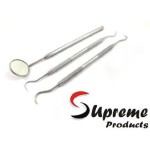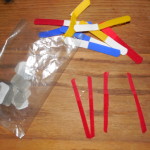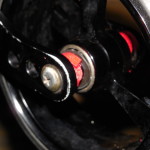About Caster Bearings
Wheelchair casters use the same sealed bearings as used for roller skates, roller blades, skate boards and scooters. The bearings in a wheelchair don’t spin at high enough RPMs to require a high-tolerance/ultra-low friction bearing. Stainless steel bearings are usually fine, without spending the extra cost for ceramic bearings.
- Bones Super REDS Bearings BSACSR88
- Bones bearing exploded
- Dimensions diagram
Casters have 8 bearings: 2 in each wheel hub and 2 in each stem. The 4 caster bearings are the same size; the 4 fork bearings are the same size. Caster and fork bearings are typically not the same size.
Periodic bearing maintenance and adjustment will make your chair roll easier and straighter. Rear-wheel bearings are high off the ground, so they don’t need much attention once properly adjusted.
Wheelchair casters are close to the ground thus pick up much debris (e.g., hair, dirt, water, etc.). They also dry out and get banged around (out of adjustment).
Caster bearings experience the harshest conditions, so need the most maintenance. I disassemble, clean, and lube my caster bearings about once a quarter. Hair may not be visible, but water and small dirt particles find their way passed bearing seals over time. I attached an article below instructing how to remove, replace, and adjust bearings.
(Courtesy of chasmengr)
Many people do not service them, but just replace them when needed. This is an overview of Bones Bearing Maintenance.
Shielded versus Sealed
Wheelchair bearings fail primarily due to contamination and corrosion from water, salt, and dirt. Even a sealed bearing is no longer sealed once it has been broken-in. During break-in, the inner lip of the seal wears down where it rotates around the inner race. This leaves a minute gap similar to the gap in a shielded assembly. Moisture, dirt, and other contaminants can enter the bearing through this gap, causing corrosion and particulate build-up, which creates increased friction and resistance.
Either one will work. It really depends on your preference. Shielded bearings have less resistance, so they spin easier. They are also tougher and will tolerate more aggressive installation techniques. Sealed bearings are less susceptible to contamination, but have more resistance due to the friction of the seal to the inner race. At wheelchair speeds, loss of lubricant is not a factor because there is not enough centrifugal force or heat expansion to create excessive internal pressure.
(Courtesy of Stubby)
“2RS” means two rubber seals and “ZZ” means two metal shields. The 608-2RS ball bearing has two contact rubber seals one on each side of the ball bearing. The 608-ZZ ball bearing has two non-contact metal shields one on each side of the ball bearing. This 8mm ball bearing is high quality and can take electric motor demands if needed.
ABEC rating
The ABEC rating (Annular Bearing Engineers Committee) denotes the quality of materials and precision used in manufacturing the bearing. Higher rated bearings are higher quality. I’ve been told that ABEC-5 is enough for a wheelchair, because it does not go at high speed. Some bearings like Bones doe not use an ABEC rating.
Recommended Types
- Bones Super REDS Bearings (sealed stainless ) [recommended by chasmengr]
- 608-2RS 608-ZZ Radial Ball Bearing 8X22X7 Skate Bearing (sealed or shielded stainless ). Interchangeable with SAE 1603-2RS 1603-ZZ Radial Ball Bearing 5/16″ Bore [recommended by Stubby]
- Stainless Steel Skateboard Bearing Sealed Ball Bearings (sealed stainless) [recommended by totoL1]
- S608-2RS Bearing 8x22x7 Si3N4 Ceramic Stainless Sealed ABEC-5 Bearings (sealed ceramic) [recommended by totoL1]
Specifications
The bearings that came with the Frog Legs EPIC Aluminum Wide Softroll Casters are 608-2RS / C3 RB Tech (China). The following are the specifications of what we will buy in future:
- Size: 8mm x 22mm x 7mm (similar to SAE: 5/16″ x 7/8″ x 9/32″)
- ID (inner diameter)/Bore=8mm (similar to SAE 5/16″)
- OD (outer diameter)=22mm (similar to SAE 7/8″)
- Width/Height/thickness=7mm (similar to SAE 9/32″)
- Quality: ABEC-5 or similar
- Material: Stainless Steel
- Balls: Stainless Steel or Ceramic (Silicon Nitride)
- Closures: Double sealed with rubber seals or sheilded metal
Interchangeability 608 (metric) with 1603 (SAE)
Technically, they are not interchangeable. But in real life, they often are. It depends on manufacturing tolerances. On machined parts, ODs are typically slightly undersized, and IDs are typically slightly oversized. An 8mm axle is only about 5/100mm larger than a 5/16” axle. Well within standard tolerances. Most 8mm and 5/16” axles are interchangeable, because the OD tends to run under. But often a 22mm bearing will be just a tad sloppy in a wheel with a 7/8” bore. Bearings with higher ABEC ratings are built to much closer tolerances internally, and tend to have much more exact race sizing.
The aluminum Softrolls are metric and use a 608 bearing (8mm x 22mm x 7mm).
(Courtesy of Stubby)
More info: http://sci.rutgers.edu/forum/showthread.php?211023-Ceramic-bearings and http://sci.rutgers.edu/forum/showthread.php?231819-Need-caster-bearings
Replacing Caster Bearings
Instructions for Removing and Replacing Bearings
I followed Toto’s video below, and I can’t say enough how helpful that was. I did it just a little different with using a rubber mallet because I was a bit paranoid. I think the trick is finding the right size bolt, which luckily we had a 7.5mm x 19 mm cap screw lying around. I also found my long misplaced caliper, so it was a double bonus!
The rubber mallet did not work as well for inserting the new bearing, because it was a pan head bolt, but a few good wacks directly on the bearing with the rubber mallet worked great. I also found the miter box helpful for wacking it on, and could easily catch the spacers in it.
Also very helpful is to freeze the bearings a few hours and use a heat gun to warm the bearing housing.
- Removing the Bearings
- Replacing the Bearings
- Replacing the Bearings
Video: How To Replace Wheelchair Bearings
Courtesy of at Paralyzed Living
Replacing ZRA standard fork bearings
After almost 10 years, I finally replaced the fork bearings. I really should have done this before one of them seized, because it was a lot of work to get the rusty bearings out.
Before starting I used a lot of penetrating oil, which worked better than DW-40. It took quite a bit of hammering on the caster cap to get the fork off of the the bearing fork stem and we ended up taking the bearing fork stem out too. Once we did that it was clear that it was very rusted. I borrowed a tool and some muscles from a friend who helped to got the fork off. Because we had some extra forks I decided to replace them. Otherwise it would need 2 R8/RS bearings per fork size 1/2″ I.D. X 1-1/8 O.D. X 5/16 W, which are the same as the rear. Note, there is a wheel C-clip between the 2 bearings that you need snap ring pliers to remove that C-clip. bearings.
Keeping hair out of casters
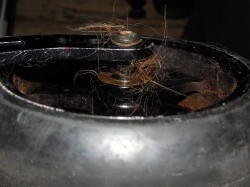 This is a long story, but basically, about once per month I need to remove twisted up hair, both human and animal from the casters. Depending on how tightly it is twisted, it can really take a long time, at least 15 minutes per caster, and it is not a fun job.
This is a long story, but basically, about once per month I need to remove twisted up hair, both human and animal from the casters. Depending on how tightly it is twisted, it can really take a long time, at least 15 minutes per caster, and it is not a fun job.
I have tried many possible solutions, but none have really worked well. What I did find interesting is that I have not cleaned out the hair from the casters in a couple of weeks, but the last time I did, I sprayed the crap out of the axles, bearings and spacers with silicone spray. I did that because I did not have time to fix a broken seal on one of the bearings. What I noticed is that they picked up as much hair as ever, but it was super easy to get off because it did not twist so tightly around the spacers. Until I find the “ultimate” solution, I’m going to keep doing this, because it is easy, and I don’t see where it can cause any harm
For more information, see Hair (etc.) in casters on CareCure forums.
Frog Shields
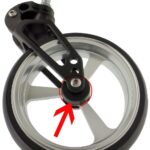 After trying most of the options below, we finally got some Frog shields. They are replacements for traditional caster wheel spacers. They can be bought at the Frog Legs webshop or from various online resellers. They only cost $19.99, but save hours of work for me each month.
After trying most of the options below, we finally got some Frog shields. They are replacements for traditional caster wheel spacers. They can be bought at the Frog Legs webshop or from various online resellers. They only cost $19.99, but save hours of work for me each month.
Creme Brulee Jet-Torch
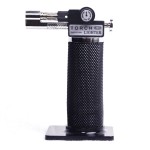 I have been using a Refillable Butane Jet Torch and overall it works quite well. It does not seem to damage the aluminium casters, but I’m concerned about the rubber sealed bearings. I asked on CareCure, if metal shielded bearings stand up better to being heated than rubber sealed bearings to burn hair out of the casters occasionally and I’ve noticed the rubber seals get soft from the heat. See Hair (etc.) in casters for more information.
I have been using a Refillable Butane Jet Torch and overall it works quite well. It does not seem to damage the aluminium casters, but I’m concerned about the rubber sealed bearings. I asked on CareCure, if metal shielded bearings stand up better to being heated than rubber sealed bearings to burn hair out of the casters occasionally and I’ve noticed the rubber seals get soft from the heat. See Hair (etc.) in casters for more information.
I have also considered trying a chemical hair remover (depilatory) like Nair, Magic Shave or Veet. The active ingredients are calcium thioglycolate or potassium thioglycolate), but I have no idea how they would react to aluminium or the rubber seals on the bearings.
Yes, grease lubricated shielded bearings are much more heat tolerant than sealed bearings. But… your torch is probably propane or butane. Air/fuel flame temperature is around 3500’F. At that temperature you are probably deteriorating the grease and the stainless steel components as well as the rubber seal. Even high-temp grease tops out around 500’F. More importantly, if you heat stainless steel above 1900’F, the material will partially anneal as it cools resulting in a decrease in hardness. You may also deplete the chromium content of the stainless alloy, which is necessary to prevent it from rusting.
Your idea of burning hair from the casters is ingenious. But the torch may be overkill. Perhaps a wooden match would do the trick. Wood burns around 900’F, which should be more than adequate for hair. I’m an old long-hair myself, so I am familiar with hair in casters. I use a dental pick to clean mine. rips it right out.
If you try the pick, make sure you get one with a hook that comes to a point.
(Courtesy of Stubby)
Dental Picks
I’m going to give dental picks a try at some point also. Here is a set at Amazon that looks like they would work.
Velcro bands
I’ve been trying to figure out how to keep people and pet hair from getting caught in the casters. What I found out is that the elastic cords I tried earlier, definitely worked. I took them off, and all of the hair went with them. That is is not a long term solution, because it was difficult to get them on and off.
I bought some cable ties from an office supply store. I cut them in half horizontally and twisted them so the Velcro would stick. They appear like they will work. Unfortunately, this picture only shows our bad seal on the bearings, but I think you will get the idea of what I am talking about. I am hoping that this is a solution that I can keep up realistically every month.See Hair (etc.) in casters for more information.
Pattherat’s “toy dispenser Monkey“
This is an idea to make a dust cover from one of those “toy dispensers”. It looks like a good solution if you can them. I’ve never seen those “toy dispensers” here in Holland, but possibly that’s because I don’t have kids or get out much.I started thinking more about things we might have on hand that would work with Pattherat’s “toy dispenser Monkey” idea (yes, I lead an exciting life!). I went to check lotion, deodorant, toothpaste caps etc. but they were all too high or not the right diameter. While I was going through the cabinets, I got thirsty — it’s Friday night here. That got me to thinking about things we do have enough of, wine and beer caps, and I just thought you might all like to see my failed attempts.
Basically, what I learned is that the material needs to fit perfectly in depth or be a bit flexible like Pattherat’s. I think he is absolutely right about this not being rocket science, and manufacturer’s need to fix this simple yet time consuming problem. As Pat mentioned, these “dust covers”, “dust caps” or “hub guards” are standard in the BMX world. What I notice is that they are all cone shaped, the same as the Schmickings (below), which must be the trick to keeping the hair from twisting around and around. Why not just make the spacers cone shaped, and the problem is solved!
- Pattherat’s toy dispenser monkey
- Failed beer cap attempt
- Failed wine cap attempt
- Failed wine cap attempt
Ball bearing covers
I also want to see if I can find something like the yellow covers on Schmicking casters as shown in this post Schmicking Patent. I was not able to source them.
- Schmicking Casters
- Schmicking Casters
Conical or Tappered Spacers
I’ve seen a few conical spacers or tappered spacers, but I’m having a heck of a time figuring out if any of the dimensions might work based on our fork spacer size: ID .316″ (8.026 mm) X OD .438″ (11.125mm) X Depth .364″ (9.245mm). I would think that the ID and Depth are the most important, as long as it’s not bigger than the bearing. The outer diameter of the 608 bearings are 22mm (around SAE 7/8″ / 0.875″).
TiLite Parts Forks and Casters
Standard Fork
We have a ZRA2 with a standard fork with Frog Leg Epic Soft Roll Casters
. I think it is AS110686-ZZRA2 STD FORK ASY,RT-BLK. This is what the parts store lists as the dimensions for the spacer: CP103945 SPACER .316”ID X .438”OD X .364” LONG.
| ITEM | QUANTITY | PART NO. | DESCRIPTION |
| 13 | 2 | CP103945 | SPACER .316″ID X .438″OD X .364″ LONG |
| 14 | 2 | CP104375 | C SPRING WASHER |
| 15 | 1 | CP103041 | CASTER AXLE, LONG |
| 16 | 2 | HD100331 | 10-32 THREAD X 3/8″ LONG PAN HEAD PHILLIPS,BLACK ZINC |
I noticed that the TiLite Slipstream Single-Sided Fork has a Caster Cap. I think it is AS110893-ZZR2 MONOFORK 1.5″ CSTR,R,BLACK. It does not give the dimensions, but I wonder if something like this would work also. This is link in the TiLite Parts store: CP104370 SINGLE SIDE CASTER ENDCAP-BLACK.
ID .316″ (8.026 mm) X OD .438″ (11.125mm) X Length .364″ (9.245mm). The outer diameter of the 608 bearings are 22mm (similar to SAE 7/8″ / 0.875)
The screws are different, with the standard fork taking HD100331 10-32 THREAD X 3/8″ LONG PAN HEAD PHILLIPS,BLACK ZINC, and the slipstream taking HD10033910-32 THREAD X 5/8″ LONG FLAT HEAD CAP SCREW, BLACK ZINC.
| ITEM | QUANTITY | PART NO. | DESCRIPTION |
| 8B | 1 | CP104370 | SINGLE SIDE CASTER ENDCAP-BLACK |
| 9B | 1 | HD100339 | 10-32 THREAD X 5/8″ LONG FLAT HEAD CAP SCREW, BLACK ZINC |
- TiLite Standard Fork Spacer
- TiLite Standard Fork Spacer Screw
- Slipstream Single-Sided Fork Caster Cap
- Slipstream Single-Sided Fork Screw
Casters
These are the parts included with the Plastic Wheel w/Poly Tire replaced with Frog Leg Epic Soft Roll Casters that might need replacing for the AS100064-Z 5″ PLASTIC POLY CASTER:
| ITEM | QUANTITY | PART NO. | DESCRIPTION |
| 1 | 1 | CP100332 | 5″ CASTER WHEEL – PLASTIC |
| 2 | 2 | HD100012 | BEARING, 8MM I.D. X 22MM O.D. X 7MM W |
| 3 | 1 | CP100083 | .438 x .450 SPACER FOR 5″ CSTR |
| 4A | 1 | CP100340 | 5″ POLYURETHANE TIRE |








